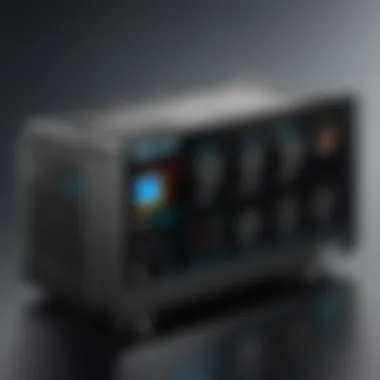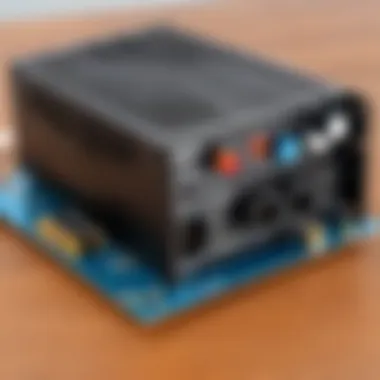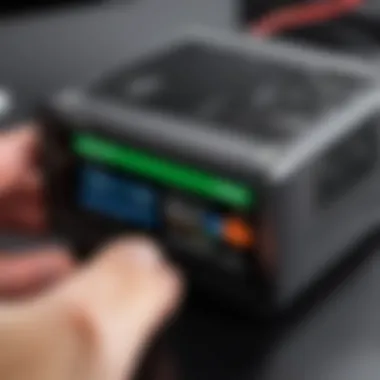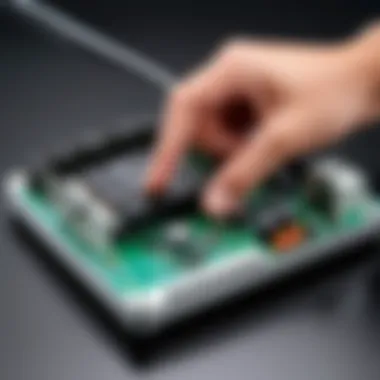Understanding Reolink Camera Power Supply: A Complete Guide


Intro
In the realm of modern surveillance, Reolink cameras stand out for their versatility and user-friendly design. However, their performance heavily relies on the power supply system in use. A thorough understanding of this component is crucial for ensuring optimal functionality and longevity of the cameras. Given that tech-savvy consumers and professionals seek reliable and efficient solutions, this guide aims to unravel the complexities of Reolink camera power supplies.
In this guide, we will cover essential aspects such as technical specifications of power options, practical applications for different user scenarios, and insights into the latest industry trends. Whether choosing the right power supply, troubleshooting issues, or maintaining optimal power integrity, this article seeks to equip readers with the knowledge they need to make informed decisions regarding Reolink camera systems.
Technical Specifications
Detailed Product Specs
A comprehensive grasp of the technical specs of Reolink camera power supplies is vital for ensuring they operate effectively. Reolink cameras typically offer options like PoE (Power over Ethernet), AC power adapters, and solar panels. The power supply's voltage and wattage must match the camera requirements to avoid performance issues or damage. For instance, a Reolink RLC-410 camera might utilize a specific AC adapter for optimal performance, which generally operates at 12V and needs to provide sufficient amperage.
Performance Metrics
Performance can vary based on the type of power supplied. PoE systems are generally efficient as they deliver power and data over a single cable, reducing clutter and installation complexity. In contrast, solar panels can be an advantageous choice in remote areas, but they require careful positioning and sunlight exposure to function properly. Understanding these metrics allows users to choose the best option based on their specific environment and installation needs.
Compatibility Information
Compatibility is another essential aspect. Not all power supplies are interchangeable, so it is critical to verify that the selected supply matches not only in voltage but also in connector type. For example, using a standard DC 12V adapter with a connector that doesn't fit a Reolink camera can lead to operational failures or damage. Always consult the camera's manual or manufacturer specifications when considering third-party products.
Product Comparisons
Feature Comparisons
When evaluating power supply options, features such as maximum wattage, efficiency ratings, and included safety features should be carefully compared. Some options may provide surge protection or built-in voltage regulation, which can protect investment in camera technology.
Price Breakdown
The prices of Reolink power supplies vary significantly based on brand and specifications. While standard AC power adapters may range from $10 to $30, more complex solutions like PoE injectors or solar panel kits could cost upwards of $50 or more. Knowing the price range for your required features can help in budgeting accurately for your camera setup.
User Experience Breakdown
Reviews and user feedback can provide valuable insights into the effectiveness and reliability of different power supplies. Users often report experiences relating to installation ease, consistency of power delivery, and overall sturdiness of products. Investigating these user experiences on platforms like reddit.com or facebook.com might help in making an informed choice.
Practical Applications
Use Cases for Different Users
Understanding how various user groups employ Reolink cameras can shape power supply decisions. For instance, residential users may favor standard wall adapters, while businesses may opt for PoE solutions due to ease of installation over large areas.
Recommended Configurations
For optimal performance, configurations should consider camera placement relative to power sources. For areas needing consistent surveillance without interruptions, using a combination of PoE with a universal back-up system can be an effective strategy. Solar panels are ideal for outdoor setups where power sources are not readily available.
Multi-Platform Performances
As technology evolves, interoperability of Reolink cameras with other devices becomes increasingly significant. Ensuring that the power supply supports multi-camera configurations and integrates with network systems is important for future-proofing a security system.
Latest Trends
Industry Developments
The surveillance industry is witnessing advancements in power technology, particularly with smarter systems that can provide real-time performance feedback. Keeping abreast of these developments can help consumers choose options that offer more than just basic functionality.


Emerging Technologies
Emerging power solutions, including battery systems that integrate with smart home devices, are becoming popular. This innovation can enhance user convenience and ensure continuous operation.
Future Predictions
In the upcoming years, expect to see consolidated systems that integrate power management into surveillance setups. The drive for efficiency and sustainability will likely shape the industry, leading to more eco-friendly options.
Buying Guides
Recommended Products
Based on extensive research and reviews, products such as the Reolink 12V Power Adapter and Reolink PoE Switch offer reliable options for users looking to streamline their camera's power supply.
Purchasing Tips
When buying, always verify the compatibility of the product with your specific Reolink model and consider purchasing from reputable sources that offer warranties. Always check for return policies too.
Warranty and Support Information
Understanding the warranty offered on power supplies is crucial. Most Reolink products come with a limited warranty that covers manufacturer defects, ensuring peace of mind when investing in power supplies.
Prologue to Reolink Cameras
Reolink cameras have gained significant recognition in the field of surveillance technology. Their user-friendly design and advanced features make them appealing to a wide range of consumers, from homeowners to business operators. This section provides context for understanding how these cameras operate, particularly focusing on the critical role of their power supply.
Overview of Reolink Products
Reolink offers a variety of camera models tailored for different security needs. Some popular products include the Reolink RLC-511, known for its high-resolution imaging and robust outdoor capabilities, and the Reolink Argus 2, favored for its wireless functionality and solar power option. Each model comes with specifications that cater to distinct environments and preferences. As these products evolve, they incorporate additional smart features and enhance user accessibility.
Key features often included across Reolink products are:
- HD Video Quality: Many models support 1080p or higher resolutions.
- Night Vision: Effective surveillance in low-light conditions.
- Two-Way Audio: Facilitates communication through the camera.
- Motion Detection: Sends alerts for any suspicious activities.
Understanding these products is essential, as the choice of camera directly influences overall security effectiveness.
Importance of Power Supply
The power supply is a foundational element in the operation of Reolink cameras. Without a reliable power source, no feature can perform optimally. Selecting the right power supply ensures continuous operation, which is paramount for surveillance systems.
Factors contributing to power supply significance include:
- Operational Efficiency: A suitable power supply minimizes the risk of interruptions, enhancing the reliability of the surveillance system.
- Device Longevity: Proper voltage and current prevent potential damage to the camera. This is crucial for maintaining the functionality of the device over time.
- Flexibility in Use: Different installations may require diverse power solutions, such as plug-in options or solar power, enabling greater adaptability as per the user's needs.
In essence, understanding the power supply of Reolink cameras allows users to make informed decisions, ensuring safety and security are prioritized.
Types of Power Supplies for Reolink Cameras
The functionality of Reolink cameras hinges significantly on their power supply systems. Choosing the right power source is crucial for ensuring clear video quality and reliable performance. This section explores various types of power supplies available for Reolink cameras, focusing on their unique traits, benefits, and considerations.
AC Power Supply Units
AC power supply units are commonly used with Reolink cameras. They convert alternating current from electrical outlets into a usable form for the cameras. AC power adapters are generally easy to install and provide a consistent power flow, which ensures that the camera operates smoothly without interruptions.


Regular power is vital for devices that operate continuously. These units often come with various wattages to match the power requirements of different Reolink camera models. When choosing an AC power supply unit, it is important to verify the camera's specifications to avoid compatibility issues. Most importantly, look for certified products to ensure safety and reliability.
Power Adapters
DC power adapters serve as another popular choice for powering Reolink cameras. Unlike AC units, DC adapters convert power into a direct current format. This makes them suitable for battery-powered models or those needing low voltage. These adapters are often lightweight and more portable, making them ideal for outdoor or temporary setups.
Ensure that the voltage and current on the DC adapter align with your specific Reolink camera model. Mismatched electrical parameters can lead to performance issues or even damage the camera. They are often equipped with various tips to fit different camera models, enabling versatility and convenience.
Solar Power Options
Solar power has gained traction as an eco-friendly alternative for powering Reolink cameras. Solar panels provide sustainable energy sourced directly from sunlight. This option is particularly beneficial for remote or outdoor locations where traditional power supplies are impractical.
Solar-powered cameras often come with built-in rechargeable batteries, enabling them to function even during cloudy days or at night. Selecting solar power options requires consideration of the local climate, as solar efficiency varies. It's essential to assess the sunlight exposure of the installation area to optimize performance.
PoE (Power over Ethernet)
Power over Ethernet technology allows Reolink cameras to receive power and data through a single Ethernet cable. This method is increasingly popular due to its simplicity and reduction in cable clutter. PoE setups can streamline installations and improve overall system organization without sacrificing performance.
While setting up PoE, consider that using a compatible switch or injector is necessary to ensure proper function. PoE can be an excellent choice for larger surveillance systems, as it simplifies wiring considerably. In addition, it provides flexibility in camera placement, allowing for installations far from traditional power outlets.
The various power supplies available for Reolink cameras cater to specific user needs, locations, and camera models. By understanding these options, users can make informed decisions that enhance their camera's performance and longevity.
Selecting the Appropriate Power Supply
Choosing the right power supply for your Reolink camera is crucial. The performance, longevity, and reliability of your surveillance system depend heavily on this decision. A mismatched or inadequate power supply can lead to many issues, including camera failure and compromised surveillance capabilities. This section will explore key factors to consider and guide you on matching specifications to your camera models.
Factors to Consider
When selecting a power supply for your Reolink camera, several elements deserve attention:
- Voltage Requirements: Each camera model has specific voltage requirements. Ensure the power supply matches these specifications to avoid damage.
- Current Ratings: Look at how much current the camera needs. Insufficient current can lead to malfunction, while excess can cause overheating.
- Environment: Consider where the camera will be installed. For outdoor setups, a power supply should be weather-resistant.
- Cabling and Distance: If using long cables, voltage drop can occur. This can lead to insufficient power at the camera end. Choose accordingly to maintain efficiency.
- Compatibility: Ensure that the power supply is compatible with the Reolink model used. Mismatched components can lead to operational issues.
Matching Specifications to Camera Models
Matching the power supply's specifications to your specific Reolink camera model is essential for proper functioning. Here are a few guidelines to help in this process:
- Review the User Manual: Each camera comes with a manual detailing the required power specifications. This document is your first stop for accurate information.
- Check the Model Number: Identify the model number and compare it with available power supplies. Sometimes, products from Reolink come with a recommended power supply, simplifying the selection process.
- Consider Power Supply Types: Different Reolink cameras may support various power supply types, such as AC, DC, or PoE (Power over Ethernet). Know which type your model accepts.
- Consult Online Resources: Websites such as Wikipedia and Reddit can provide additional insights and guidance from other users and experts.
- Testing: If possible, test the power supply before final installation. Ensure that it operates correctly without any faults.
Installation of Reolink Camera Power Supplies
Proper installation of power supplies for Reolink cameras is essential to ensure their functioning and longevity. The quality of installation can significantly impact the performance of the camera. When done correctly, it not only enhances the camera's effectiveness but also reduces the likelihood of technical difficulties in the future. This section addresses how to properly install these power systems and highlights common pitfalls to avoid. Understanding these elements can make a substantial difference in the user experience with Reolink cameras.
Step-by-Step Installation Guide
- Choose the Right Location: Select a location close to a power source. Ensure the area has minimal interference from objects or walls to maintain a stable power supply.
- Gather Necessary Tools: Prepare tools like a screwdriver, a drill (if mounting is required), a level, and all components supplied with the camera.
- Connect Cables Correctly: Follow the manufacturer's guidelines for connecting power cables. Ensure polarity is respected in DC connections, as incorrect connections can lead to damage.
- Secure the Camera: Mount the camera securely in its designated location. Ensure it is firm and stable, avoiding any risk of falling due to a bad installation.
- Test Power Supply: Before finalizing the installation, power up the camera and check that it operates as expected. If it doesn’t power on, recheck the connections.
- Seal and Protect Connections: If cables are exposed to the elements, use waterproof connectors. This minimizes the risk of moisture damage.
- Monitor the Performance: After installation, keep an eye on the camera’s functionality over the next few days to ensure everything is working correctly.
Common Installation Mistakes
Installations can go awry due to various reasons. Here are some common mistakes to watch out for:
- Ignoring the Manual: Sometimes users rush through the installation without reading the user manual. This may lead to errors in connection or placement.
- Overtightening Screws: Using excessive force can damage both the camera and the mounting surface.
- Inadequate Weatherproofing: Failing to properly seal connections can lead to water damage, particularly in outdoor installations.
- Poor Cable Management: Neglecting to manage cables can create unwanted tension or exposure, risking disconnection or damage.
- Forgetting to Test Before Finalizing: Skipping the testing phase can result in a non-functional camera, necessitating a frustrating reinstallation.
Proper installation influences not just functionality but also the lifespan of your Reolink camera. Avoiding common mistakes can lead to better surveillance outcomes and reduce the headache of troubleshooting later.


Troubleshooting Power Supply Issues
Understanding power supply issues is essential for maintaining the efficiency of Reolink cameras. A reliable power source ensures that the cameras function optimally, providing quality surveillance. When power problems arise, they can lead to malfunctioning cameras, failed recordings, or compromised security. Thus, knowing how to identify and resolve these issues is critical for users.
Identifying Power Problems
The first step in troubleshooting is to recognize the signs indicating a power supply problem. Common signs include cameras not turning on, intermittent connectivity, or poor video quality. Some specific indicators to look for include:
- No Power Indicator Light: If the camera does not show any indicator light, this could signify a power failure.
- Frequent Reboots: Cameras that restart unexpectedly may have issues with power delivery.
- Video Dropouts: If footage is regularly lost or delayed, the power supply may not be stable.
- Error Messages: Some Reolink cameras display error messages related to power issues on the app or interface.
If you notice any of these symptoms, it is essential to check the power supply setup before drawing conclusions about the camera itself. This may involve inspecting connectors, checking cables, and ensuring that the socket provides the correct voltage.
Resolving Common Issues
Once a power issue is identified, resolving it promptly enhances the functionality of the Reolink camera. Here are some steps to address these common issues:
- Inspect Power Connections: Ensure all connections are secure and that there are no visible signs of damage.
- Test the Power Outlet: Use another device to confirm that the power outlet is operational.
- Replace Cables or Adapters: Sometimes, the issue lies with worn or faulty cables. Replacing these can restore power.
- Use a Different Power Supply: If you suspect the original power supply is inadequate, trying a new one that meets the camera’s specifications may help.
- Check for Firmware Updates: Updating camera firmware can sometimes resolve unknown power issues related to software glitches.
Regular maintenance and proactive checks can greatly reduce the risk of power-related issues.
By following these steps, users can efficiently troubleshoot power supply problems with their Reolink cameras, ensuring consistent performance and reliability.
Maintaining the Power Supply System
Maintaining the power supply system of Reolink cameras is crucial for ensuring longevity and reliability. Cameras rely on a consistent power source to function. Without proper maintenance, the risk of power failures increases, potentially disrupting surveillance and leading to data loss. Regular oversight helps in identifying issues early, enabling effective resolution. The benefits of a well-maintained power supply system are significant as they enhance performance and can prolong the life of the equipment.
Regular Inspection and Testing
Conducting regular inspections and testing of the power supply units is an essential aspect of maintenance. This practice allows for the early detection of potential problems such as loose connections or faulty cables. It is advisable to schedule inspections at least every three months.
- Check the physical condition of the power adapters. Look for any frayed wires or burnt connectors, as these can be signs of serious issues.
- Test the voltage output of the power supply to ensure it is consistent with the specifications of the camera model. This can often be done using a multimeter.
- Confirm that the power sources are functioning correctly by observing the camera's performance. Any discrepancies such as intermittent video feed may indicate a power supply problem.
Signs of Wear and Tear
Identifying signs of wear and tear is vital for maintaining the integrity of the power supply system. Some common indicators include:
- Diminished video quality: Any degradation in the camera's image quality could signal power delivery problems.
- Overheating components: Excessive heat can be a warning sign, often implying that power supply units are failing or overloaded.
- Frequent power interruptions: If the camera experiences regular outages or requires a reset, this may indicate aging or malfunctioning power supplies.
Paying attention to these signs will help maintain the effectiveness of Reolink cameras and minimize downtime.
Culmination
The conclusion acts as an essential wrap-up of the discussion on Reolink camera power supply systems. It is a space to emphasize key points that have been covered in the article and to solidify the importance of understanding these systems for anyone who possesses or is considering acquiring Reolink cameras. From identifying the right power supply to installation and maintenance, every aspect contributes toward enhanced functionality and reliability.
Ensuring that the correct power supply is used is vital. It affects not only the performance of the cameras but also their longevity. Covers factors like power requirements, installation methods, and ongoing maintenance, ultimately leading to a more efficient and effective surveillance system. If users ignore these aspects, they risk encountering frequent outages or operational failures of their cameras.
By highlighting the benefits and precautions discussed, the conclusion settles the matter of why proper power supply management is fundamental. It clearly outlines that these systems serve more than basic functions; they are core to the overall effectiveness of any security solution.
Summary of Key Points
- Diverse Power Options: Understanding various power options, including AC power supply units, DC power adapters, solar power options, and Power over Ethernet, enables users to select the best fit for their needs.
- Installation Considerations: Proper installation is crucial. A step-by-step approach ensures that users avoid common mistakes.
- Troubleshooting Techniques: Recognizing power problems early and knowing how to resolve them can save time and resources.
- Maintenance Practices: Regular inspection and awareness of signs of wear contribute to a more reliable power supply system.
Final Recommendations
When choosing a power supply for Reolink cameras, consider the environment and specific requirements of your configuration. Here are some recommendations:
- Assess Power Needs: Calculate the total power requirements based on the number of cameras and their specifications.
- Choose Quality Components: Opt for reputable brands and products that meet the technical standards of Reolink cameras.
- Follow Installation Guides: Adhering to manufacturer guidelines for installation can drastically reduce complications.
- Implement Regular Checks: Establish a maintenance schedule to inspect power supply systems, ensuring longevity and reliable performance.
Taking these recommendations into consideration can significantly enhance the operational efficiency of camera systems, ensuring peace of mind through effective surveillance.







